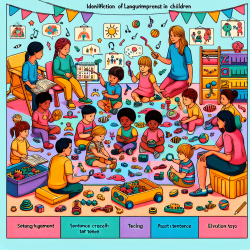Empowering Early Autism Detection: Harnessing Gaze Preference and M-CHAT-R
In the realm of speech-language pathology, data-driven decisions are paramount to improving outcomes for children. Recent research titled Autism Detection in Children by Combined Use of Gaze Preference and the M-CHAT-R in a Resource-Scarce Setting offers a promising approach to early autism spectrum disorder (ASD) detection, especially in resource-limited settings. This blog delves into the findings and implications of this study, providing practitioners with insights to enhance their screening practices.
Understanding the Research
The study conducted by Jensen et al. (2021) explores the effectiveness of combining gaze preference analysis with the Modified Checklist for Autism in Toddlers-Revised (M-CHAT-R) as a screening tool for ASD. The research involved 101 children, aged 36 to 99 months, in Lima, Peru. The study's primary aim was to validate a low-cost, portable gaze-preference system as a viable screening tool for ASD, alongside the M-CHAT-R.
Key Findings
- The combined use of gaze preference and M-CHAT-R (GP-MCHAT-R) significantly improved the screening accuracy for ASD, with an area under the curve (AUC) of 0.89 compared to 0.78 for M-CHAT-R alone.
- Gaze preference analysis in the first 15 seconds of a video was as predictive as the entire video duration, highlighting the potential for efficient screening processes.
- The study demonstrated that children with ASD spent significantly less time focusing on social scenes compared to typically developing (TD) children, providing a behavioral marker for early detection.
Implications for Practitioners
For practitioners, the integration of gaze preference analysis with traditional screening tools like M-CHAT-R offers a more robust approach to early ASD detection. Here are some actionable insights:
- Adopt the GP-MCHAT-R Model: Implementing this combined screening tool can enhance specificity and sensitivity, crucial for early intervention opportunities.
- Focus on Early Screening: Prioritize screening at 18 and 24 months, as recommended by the American Academy of Pediatrics, to leverage early intervention benefits.
- Utilize Portable Tools: The study underscores the feasibility of using simple, portable devices for gaze preference analysis, making it accessible even in resource-scarce settings.
Encouraging Further Research
While this study provides a foundation for improved ASD screening, further research is essential to refine these tools and validate their effectiveness across diverse populations. Practitioners are encouraged to explore additional studies and contribute to the growing body of evidence supporting innovative screening methods.
To read the original research paper, please follow this link: Autism Detection in Children by Combined Use of Gaze Preference and the M-CHAT-R in a Resource-Scarce Setting.










